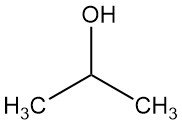
2-Butanol, also known as sec-butanol, is a colorless liquid with the formula CH3CH(OH)CH2CH3. It is a secondary alcohol and unlike its structural isomers, 1-butanol, isobutanol, and tert-butanol, 2-butanol is chiral. This means it exists in two forms, (R)-2-butanol and (S)-2-butanol.
Table of Contents
2-Butanol is produced by the acid-catalyzed hydration of 1-butene and 2-butene. These alkenes are derived from the petroleum cracking process, making them readily accessible and cost-effective feedstocks.
The majority of 2-butanol produced undergoes further conversion to 2-butanone (methyl ethyl ketone).
1. Physical Properties of 2-Butanol
2-Butanol is a colorless liquid with a distinctive odor that emits vapors with irritant effect on mucous membranes and induce narcotic effects at higher concentrations. It is completly miscible with common organic solvents.
Table 1 provides an overview of the key physical properties of 2-butanol:
| Property | Value |
|---|---|
| Molar mass | 74.12 g/mol |
| Melting point | -114.7 °C |
| Boiling point | 99.5 °C |
| Densit | 0.8065 g/cm³ |
| Refractive index | 1.39719 |
| Viscosity (20°C) | 3.6 mPa·s |
| Specific heat (20°C) | 2.81 J·g⁻¹·K⁻¹ |
| Heat of vaporization | 562.75 J/g |
| Heat of combustion | 35.920 kJ/g |
| Critical pressure | 42 hPa |
| Critical temperature | 263 °C |
| Surface tension (room temp.) | 23.5 mN/m |
| Dielectric constant (room temp.) | 15.5 |
| Solubility in water (20°C) | 12.5 wt% |
| Solubility in water (30°C) | 18 wt% |
| Solubility of water in 2-butanol (30°C) | 36.5 wt% |
| Rotation ([α]20D) (+) (S) 2-butanol | +13.73° |
| Rotation ([α]20D)) (-) (R)-2-butanol | -13.79° |
| Flash point | 24 °C |
| Ignition temperature | 390 °C |
2. Chemical Properties of 2-Butanol
Dehydration
2-Butanol shows less tendency to undergo dehydration compared to other butanols.
Dehydration of 2-butanol leads to 2-butene with high selectivity.
Oxidation
2-Butanol is dehydrogenated to 2-butanone at about 350 °C.
Oxidation with oxidizing agents like manganese (IV) oxide or suitable catalysts at higher temperatures is also possible.
Unlike primary alcohols, 2-butanol cannot be directly oxidized to a carboxylic acid.
Alkylation
2-butanol can be used in various alkylation reactions with amines or ammonia to obtain N-alkyl-, N,N-dialkyl-, or N,N,N-trialkylamines.
Ring alkylation of aromatic hydrocarbons is possible with Friedel–Crafts catalysts.
Esterification
2-butanol reacts slower than primary butanols and faster than 2-methyl-2-propanol to form butyl esters with organic and inorganic acids, acid chlorides and acid anhydrides.

3. Production of 2-Butanol
2-Butanol is synthesized by hydration of 1-butene or 2-butene or a mixture of both.

1. Acid-Catalyzed Hydration
This traditional method involves the addition of water to the corresponding butene under the influence of acidic catalysts, typically concentrated sulfuric acid. Notably, Markovnikov’s rule directs the water addition, favoring the secondary alcohol products.
This selectivity advantage allows for targeted production of 2-butanol from mixed olefin feedstocks, like C4 fractions from petroleum cracking (n-butene and 2-butene).
n-Butene hydration is catalyzed with sufuric acid at a concentration of (75-80%). However, controlling reaction temperature is crucial, as excessive heat promotes olefin polymerization.
2. Direct High-Temperature Hydration
Emerging as an alternative, direct hydration of olefins at elevated temperatures (220-300 °C) and pressures (10-35 MPa) finds industrial application for 2-butanol production. Tungsten oxide and aqueous aluminum hydroxide suspensions are a potential catalysts for this reaction.
4. Uses of 2-Butanol
Practically the entirety of the produced 2-butanol undergoes a dehydrogenation process, leading to the formation of 2-butanone, commonly known as MEK or methyl ethyl ketone. This compound has gained significant prominence due to its commendable solvent properties and a favorable boiling point of 79.57 °C.
2-Butanol itself is used as a solvent in mixtures with aromatic hydrocarbons. This characteristic makes it highly suitable for use as a solvent in the formulation of alkyd resins and ethylcellulose lacquers. It is able to dissolve both water and oils, making it instrumental in the production of brake fluids and cleaning agents.
Additionally, the conversion of 2-butanol into amines by reaction with ammonia diversifies its applications.
The acetate derivative is an effective solvent for nitrocellulose, while the xanthate form finds utility in ore flotation processes.
Beyond these industrial uses, 2-butanol plays a role in the manufacturing of perfumes, dyestuffs, fruit essences, and wetting agents.
5. Toxicology of 2-Butanol
2-Butanol exhibits moderate acute toxicity. The reported oral and dermal LD50 values in rats are 2190mg/kg and 2000mg/kg, respectively. Inhalation exposure is more potent, with an LC50/4h of 48.5mg/L in rats.
Similar to other butanols, 2-butanol acts as a central nervous system depressant. However, acute intoxication was not observed in mice exposed to relatively high concentrations (1650 ppm) for extended periods (420 minutes).
While non-irritating to rabbit skin, 2-butanol caused severe corneal injury upon ocular application. Industrial exposure at around 100 ppm is generally well-tolerated. Nevertheless, excessive inhalation can lead to irritation of the eyes, nose, and throat, alongside headaches, nausea, fatigue, and dizziness.
Exposure Limits:
- Threshold Limit Value (TLV): 100 ppm (Time-Weighted Average, TWA)
- Short-Term Exposure Limit (STEL): 150 ppm
These established exposure limits highlight the need for appropriate ventilation and personal protective equipment in occupational settings to prevent adverse health effects associated with excessive 2-butanol exposure.
Reference
- Butanols; Ullmann’s Encyclopedia of Industrial Chemistry. – https://onlinelibrary.wiley.com/doi/10.1002/14356007.a04_463.pub3




